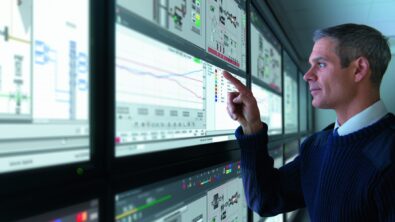Digitalizing urban air mobility for green city transportation

Urban air mobility (UAM) is an exciting concept for short-range transportation that has been gaining a lot of traction in recent years. The idea of UAM is to have a network of small aerial vehicles shuttling passengers across cities — autonomously in many cases. This sounds like something straight out of a science-fiction novel, yet the efforts of aviation companies are bringing it closer to reality. Why, though, should cities consider adopting UAM in their transportation networks? And if they do, how can the aircraft and those networks be reliably developed, implemented, and maintained? The benefits of UAM are clear, offering improvements to city infrastructure and providing sustainable transportation while at the same time presenting numerous challenges which can be addressed through the application of the comprehensive digital twin.
A new transportation infrastructure
As city planners grow more conscious of environmental and economic concerns, the improvement of cities’ transportation infrastructure is becoming a larger priority. Decreasing traffic congestion is a significant portion of this goal, with many densely populated cities like Los Angeles, New York City, and San Francisco being known for congested streets. Heavy traffic impedes all road-based activity, such as trucks transporting goods, public transportation systems like buses, and inhabitants needing to traverse the city. Urban air mobility can alleviate street congestion by providing an alternative mode of transportation above the city rather than through it. These aerial vehicles can transport passengers across the city faster than traditional ground-based vehicles and could eventually be used to transport cargo too. This will drastically lessen the number of vehicles on the road, resulting in a cleaner and more efficient transportation infrastructure for cities.
Battery-driven air travel
UAM is also a driver for sustainable air travel thanks to its compatibility with electric batteries. As discussed in a previous post, electrifying aircraft with battery power is challenging, as batteries are very heavy while being less energy dense than fossil fuels. This makes electrification difficult to implement for large aircraft like passenger airplanes since the number of batteries required to match the power output of current internal combustion engines would end up weighing too much for takeoff. Fortunately, UAM vehicles are very small in comparison with many designs planned to carry, on average, only two to eight passengers. As lightweight aircraft, they will not need as much power, decreasing the required number of batteries and making it possible to fly with zero emissions. This makes UAM the perfect beginning for a wave of widespread electrified air travel.
Digitalized transportation networks
Developing and utilizing any UAM services will benefit from the application of the comprehensive digital twin to the lifecycles of the aircraft and their transportation networks. Like other aircraft, UAM aircraft are a product of complex multidisciplinary engineering that must provide safe, comfortable flights for their passengers above all else. The importance of safety is doubled for autonomous vehicles, which must rely on sophisticated software and AI algorithms in lieu of a human pilot. This is especially crucial considering each city will have their own unique skyline and set of requirements that UAM transportation networks and their vehicles must navigate. Creating a digital twin of those networks will go a long way to alleviate these concerns. The digital twin will assist engineers when designing vehicles and maintain a constant flow of data throughout a transportation network while servicing a city, allowing it to adapt to unexpected conditions, identify key areas that could be improved, and maintain communication in the unlikely event of an emergency. With the support of the comprehensive digital twin, UAM vehicles can provide their services in a safe, reliable manner.
Cities of flight
There is certainly a lot of potential in urban air mobility. Its status as sustainable, autonomous aerial transportation and its benefits toward city infrastructure make it a worthy idea to pursue. Yet, like any technology, it must be applied and directed in a way that guarantees safety and minimizes risk. The digital twin will assist greatly in designing UAM vehicles, maintaining transportation networks and data while in operation, as well as adapting those networks to the cities they operate in to provide safe flights. With digitalized urban air mobility, we will soon be able to appreciate our city skylines from a new bird’s eye view, all while reaping the benefits of a sustainable and autonomous transportation system.
Siemens Digital Industries Software helps organizations of all sizes digitally transform using software, hardware and services from the Siemens Xcelerator business platform. Siemens’ software and the comprehensive digital twin enable companies to optimize their design, engineering and manufacturing processes to turn today’s ideas into the sustainable products of the future. From chips to entire systems, from product to process, across all industries, Siemens Digital Industries Software is where today meets tomorrow.


